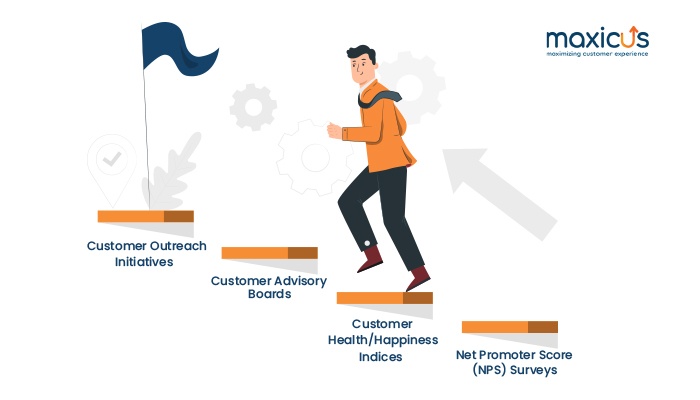
Customer lifecycle management can help you assess, monitor and accordingly, strategize your business strategy.
Consumer behavior and expectations are changing every now and then, and it is necessary that brands are able to recognize and apply it to their plans.
The following blog on Customer lifecycle management — is simplified for you to understand its meaning and understanding various lifecycle stages – what are they, what do they consist of and how do we measure them?
Scroll down to read more.
Get a call back
Customer Lifecycle Management (CLM) is defined as the measurement of progression a customer goes through during the buying lifecycle; which consists of multiple stages including awareness, consideration, purchasing, and usage – ultimately leading to maintaining customer loyalty to a product or service.
Customer lifecycle marketing is a high-level approach to personalized customer communications, based on recognizing that different marketing messages and strategies work best for customers at different stages of their journey with a brand. To forge stronger relationships with your customers, you need to understand the distinct lifecycle stages that your customers go through and provide the highest value at each stage, to realize the most effective customer engagement, monetization and long-term retention.
There are several reasons right off the bat to consider a lifecycle management software or tool for your customers if you’re not already using one. These include providing further value to your customer relationships, maintaining these preexisting relationships, and boosting your company’s brand loyalty.
As any company wants to make more money, you have a greater chance of successfully cross-selling and upselling through a CLM than you do without one. Since your customers are already more in-tune with the company thanks to your relationship-building, they could take advantage of these additional offers. This puts more money in your company’s pocket, which is always a good thing.
While it would be impossible to present a single customer lifecycle model that applies to every single business out there, experts have settled on a handful of basic stages that are common to the majority of companies.

The first step or stage of the customer lifecycle is the approach stage. Most of the work is on the shoulders of the sales and marketing teams here, as the customer is still a lead by this point. The goal is to convert them to customers, but before that can happen, the sales and marketing teams must ensure the leads are even worth working with.
Now, through segmentation, you’d split your leads based on demographics like age, gender, location, occupation, job title, income, pain points, and more. The most valuable leads become prospects, marketing-qualified leads or MQLs, and sales-qualified leads or SQLs. These are the ones you want to offer your products to, illustrating how valuable they are as part of the approach stage.
From the approach stage, you enter the acquisition lifecycle stage. At this point, you have very interesting leads or prospects who are quite likely to become customers. They jump into your company’s sales pipeline and begin their progress early.
The duties of your company are multiple during this stage, in that you must have dedicated sales and customer service agents available to answer the inevitable questions and concerns your leads will have.
Besides that, your marketing and sales teams must do their best to showcase the usefulness and value of the product or service you’re trying to sell to each group of leads. Remember that segmentation still matters here, as even the most qualified leads won’t have identical pain points. In segmenting your leads, you may try to market several products/services, dividing these among your various audience groups.
This is where the rubber meets the road. In other words, you win the sale and the prospect becomes a customer. The key to success in this stage focusing on selling the relationship, not just the product.
At the most basic level, conversion happens when a customer remits payment to begin using your product or service.
One of the most important sales conversion metrics is the conversion rate, which tells you what percentage of leads ended up turning into customers.

For example, if you made 20 sales in a month and you had 2,000 unique visitors to your site, your conversion rate would be 1%.
Your conversion rate isn’t going to be 100%. You’re going to lose some sales. And at that point, the customer lifecycle for those prospects will come to an end. But that doesn’t mean you should immediately seal their files and lock them away forever. Instead, look at lost sales as learning opportunities. Furthermore, you should be tracking and storing this information so you can use it to inform future sales and marketing efforts and strategies.
Okay, you’ve scored the touchdown (i.e sale done). You may have won the battle but not the war yet. After all, the customer truly holds the power; chances are, there are a lot of other options out there, and in the modern marketplace, it’s easier than ever for customers to jump ship or walk out your back door, never to return. That’s why it’s so crucial that you form a strong partnership with each customer.
In reality, the retention phase includes several smaller phases, we can also name it the customer journey map.

Onboarding phase:
The onboarding process begins immediately after purchase. Your goal is to get your customers up and running as soon as possible. But that doesn’t mean handing them the keys and turning them loose right off the bat. After all, if they attempt to use your product with no guidance or training, they probably won’t be successful, and that will lead to frustration. Which could lead them to regret their purchase down the road.
To counter that, You should create a checklist of all the milestones that your customers must complete to use your product successfully from the first time they put the key in the ignition. That list should include:
Keep in mind, onboarding is your customers’ first real experience with your product and your company, and the impression you make during the onboarding process will stick with them and influence their satisfaction level for the rest of the customer lifecycle.
Support phase
Once a customer has completed the onboarding process and has begun using your product, you must keep the lines of communication open in case the customer has any problems, questions, or concerns. This is especially true during the first few days, because if the customer does not immediately begin to see value in your product, then he or she will be much more likely to ultimately leave you.
68% of customers leave because they perceive that you are indifferent to them.

This is where the churn rate comes into the picture. Simply put, your churn rate tells you how many existing customers you’re losing and how fast they’re leaving you. So, you must provide your customers with an easy means of obtaining on-demand support so you can correct problems promptly and get back to delivering value to those customers as quickly as possible.
Adoption Phase
One of the reasons support is so crucial the first couple of months after the sale is that this is the period during which the customer should successfully adopt your product. What does that mean? It means the product becomes integral to the customer’s daily activities and operations.
You should monitor adoption by tracking customer use, activity, and progress toward defined milestones. To get a feel for the specific data points you should be tracking, start by digging into your churn data. Pinpoint those customers who have left you because they didn’t get enough value from your product. Why weren’t they seeing value? Could you have done something to change that?
Engagement phase
The only way to ensure your customers are happy and successful is to continually engage with them. This includes monitoring their satisfaction through:

Getting the most out of your engagement efforts means harnessing the combined power of technology and human interaction. After all, technology might be able to pinpoint areas of opportunity, but it alone cannot ensure your company continues to deliver value.
You should be engaging with your customers across the entire spectrum of the customer lifecycle. However, keep in mind that the elements of engagement will change as the customer progresses through his or her lifecycle.
Pro tip:
“You won’t or at least, you shouldn’t—engage with your one-week-old customers the same way you engage with your one-year-old customers.”
Expansion phase
Many companies view upselling and cross-selling opportunities as a means of extracting as much revenue as possible from each customer. But that mode of operation isn’t sustainable in the long run. Because if you upsell and cross-sell with reckless abandon, you can’t be sure you’re actually providing additional value to the customer. And if you’re not, your customers will catch on—and when they do, boom: all trust is lost. It won’t be long before those customers walk out the back door.
Instead, you should approach expansion with a goal of helping your customers extract as much value out of your product as possible. Create a customer experience that delivers increasing amounts of value over time, creating a natural growth in base-product use, a logical expansion into additional functionality, and where appropriate, adoption of adjacent products from your company.
This means using data to launch intelligent expansion efforts—ones that truly will deliver value.
Brand loyalty is an emotional commitment. To achieve customer loyalty, brands must make it worthwhile for consumers to side with them instead of defecting to competitors. While it’s costly in terms of time and effort to search for a new company, feeling unvalued in a relationship is never sustainable. Top brands spend the extra effort to show customers that their money is well spent – and in turn, get the rewards.
In a perfect world, every single customer you acquire would make it to this stage. At this point, the customer is not only satisfied with your product but also delighted. He or she is a brand ambassador. Someone who sings your praises via online and in-person reviews, recommendations, or testimonials- all of which are extremely powerful when it comes to attracting more customers.
After 10 purchases, you refer to 50% more people than a one-time purchaser.”
Utilizing referral and loyalty programs is especially effective for brands looking to engage with their best customers, promote repeat purchasing, and also attracting new users. The customer psychology behind social proof tells us that consumers trust each other especially when it comes to purchasing recommendations. Social Proof is amazingly powerful when your Ideal Customer prospects see others like them using and succeeding with your product, there’s a level of validation that trumps just about everything else you say or promise.
The lifetime value of a customer, or customer lifetime value (CLV), represents the total amount of money a customer is expected to spend in your business, or on your products, during their lifetime. This is an important figure to know because it helps you make decisions about how much money to invest in acquiring new customers and retaining existing ones. Customer lifetime value has become more important on the agenda for brands across industries.
A study shows that among the companies who are doing a good job measuring CLV, 81% have improved their sales results and 57% are implementing more timely marketing actions.
Essentially, calculating and monitoring customers CLV effectively can give you a broad perspective of how customers relate to your brand across the funnel – from content and social media to after you close the deal. Your team can then redirect investments more accurately.
CLV can be used through different business functions, including marketing and customer experience (CX) management. On top of that, it ultimately allows you to improve a bunch of metrics related to customer acquisition and customer retention, churn, and ad performance.
A strong customer relationship can last for years. How do you begin to manage all the potential outcomes, needs, and variables that determine the path ahead?
Break it down into small steps.
The customer lifecycle management process segments the customer journey into stages, including onboarding, adoption, support, and engagement etc. This modular approach lets you focus on goals-based, results-driven KPIs that guide the customer and help them reap benefits from the use of your product. Defining your customer journey also gives you a clear set of milestones and goals to benchmark customer progress.
The customer journey stages reflect how a customer grows with your product and your brand. They define a clear way to track the customer experience, measure it against proven metrics, increase value, and reduce churn.
Each stage of the customer journey can be broken down into a series of practical goals and KPIs. The onboarding phase, for example, is about educating the customer and helping them incorporate the product into their daily workflow. You focus on speeding up time to value, maximizing license utilization, and demonstrating the value of key product features. The onboarding stage then logically flows to adoption, where the customer uses this newly acquired product knowledge to garner maximum business value.
It is important to note, however, that the customer journey is not linear. Customers can experience escalation while they’re in the midst of renewal, or some circle back to onboarding due to an upsell.
To increase your chances of building a mutually rewarding partnership, you have to pursue clear goals every step of the way. These goals evolve with the needs of each customer, but there are best practices that you can employ to make the most of the customer lifecycle management process:
Use Data to Drive Timely and Relevant Engagements:
Customers have different needs at each stage of the journey. To best serve them and to anticipate future needs, focus on information that is relevant to their current circumstances. Metrics such as product access, usage time, and feature usage can guide engagement efforts.
Suppose, the first days and weeks after a customer has completed onboarding are critical and may require a different approach than a customer who has been live for quite some time. Setting up a unique health profile for these “young” customers and employing a higher-touch engagement strategy will help ensure early adoption.
Measure and Track Progress Against KPIs and Goals:
One of the first steps in the customer lifecycle management process is identifying your goals and tracking the KPIs necessary to measure progress. It helps to use a modular approach, breaking the customer journey down into stages and using unique goals depending on the particular phase a customer is in. By tracking progress, you should be able to identify what is working and what could use more finesse.
For instance, in the adoption phase, the customer success team is working to ensure customers are effectively using the product. They’ll do this in a variety of ways, which can include hosted training sessions, regular check-ins, and adoption-focused drip campaigns. The effectiveness of these efforts can be measured by identifying specific actions and activities the customer should be doing within the product.
Scale Customer Success:
Customers expect the same level of personal attention throughout their journey, but it is difficult to maintain high-touch engagements across a growing portfolio. Grouping customers with similar characteristics and product histories can help you stay aware of their evolving needs and identify behaviour patterns.
For example, you can tailor your messaging to specific customer segments based on your understanding of what these businesses value, how their peers have responded to previous campaigns, and what they will need for future growth.
Share Customer Data Across the Enterprise:
Every customer interaction generates information. By sharing this data across the enterprise without password barriers and siloed databases, you inform the next customer engagement and can anticipate customer needs. During the support phase, Knowledge of customer history allows the customer success team to better understand the problem.
Prepare Campaigns for Each Stage of the Customer Journey:
The customer lifecycle management process lets you create product engagement campaigns that address each phase of the customer journey. This modular approach is helpful for making sure nothing slips through the cracks.
During onboarding, create messaging that strongly links the product and its features to customer business goals. During adoption, prioritize the experience of new value by encouraging the adoption of advanced product features or expanded product usage. Support brings a need for rapid and personalized customer response, while Expansion should focus on future growth and acknowledging past achievements.
Identify Advocates:
Use Net Promoter Scores (NPS) to identify which customers are at-risk (detractors) and which are highly satisfied (advocates). Once you know who your advocates are, you can include them in a case study or ask them to provide references.
For example, you are notified that a certain customer has a high NPS of 10. This customer is clearly happy with your brand and product and you want to be sure you know why. You reach out asking for a reference and feedback on what they love about working with your enterprise.
Implementing these best practices will help you deliver value at every phase of the customer lifecycle.